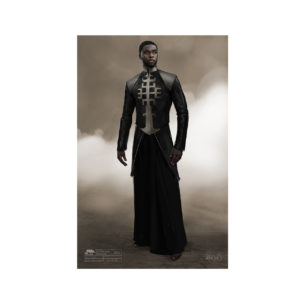
Even after over 50 films and television series as costume designer, Ruth E. Carter had never worked on a traditional superhero movie. However, this assessment depends upon one’s point-of-view. “I feel like I’ve been doing superheroes all my career,” she said upon reflection. “Malcolm X was a superhero; Martin Luther King was a superhero. You are still creating a world, and the elements of creating that world are the same.”
Consequently, Carter approached the Marvel Studios epic Black Panther as she would any period film. “You are delving into the times, and this happens to be a futuristic time,” she observed. “It’s a world where nobody has been, so that actually gave us a lot more latitude in terms of the creativity.”

Before Carter joined the project, visual ideas for several characters had been developed by conceptual artists, including Anthony Francisco and an additional core team. “When I come on,” Carter said, “Marvel is handing this over to me, and entrusting me in the visual conception of these costumes. That means I have to decide how to bring them to life.”
Working with director Ryan Coogler on his first superhero film, Carter pointed to Coogler’s particular aesthetic. “He cares about his own visual relevance, and I think that tapped into the Afro-futuristic model,” Carter described. “ It’s an African diaspora that Spike Lee also wanted to project when it came to how blacks are portrayed in cinema. So when I worked for Spike, we never wanted to do anything that was stereotypical—we really wanted to show the beauty and complexity of the African exclusion in this country, and I felt like Ryan was trying to do the same thing.”

Jumping into designing and creating the costumes for Black Panther, Carter described the effort as “a creative explosion.” With shoppers in Africa and South Korea, Carter would review materials at all hours of the day in making her creative choices. “I had a huge responsibility to the fans, to Marvel, to Ryan, to myself,” she revealed. “Your mind is in this mode of, ‘Is this the right color, is that the right shape, did that fitting go well, do I need to revisit something?’ That’s constant, but I wouldn’t trade it for anything in the world. No one could do these types of films back to back to back. I feel like you have to feed your creative energies by stopping and going to the movies, the theatre, listening to music, or painting a canvas.”

Inspired by fashion designers such as Gareth Pugh, Carter aimed to give Angela Bassett, playing Ramonda, a regal presence, especially in her introductory scenes. “It was patterned behind African lace, then 3-D printed, so it was a semi-flexible item, but I needed it to feel light and airy because she’s wearing it on her shoulders,” detailed Carter. “Also, her crown, which is a Zulu hat, is a married woman’s hat in the South African tradition, that I felt like needed to be a perfect circle. There’s no way you can hand make a perfect circle so we did it on the computer; we designed the algorithms and had it printed in Belgium, which was the only place that had the large 3-D printers and used this flexible material.”



Working out of a sound stage in Atlanta filled wall-to-wall with her exotic costumes, Carter was present the full four months of principal photography. She noted that the aspect of Black Panther which most appealed to her was the fact that the film’s look had not been previously established. She is now in pre-production on Silver & Black, aka Silver Sable & Black Cat, with director Gina Prince-Bythewood, featuring two female superheroes in the Marvel Universe.

In closing, Carter noted her longtime primary affinity for her craft: working with actors. “Michael B. Jordan was very clear about who he was playing,” she conveyed of his character of Erik Killmonger. “When he found a costume that he loved, he was very happy. I just love the collaboration between the actor/character and the costumer designer.”






